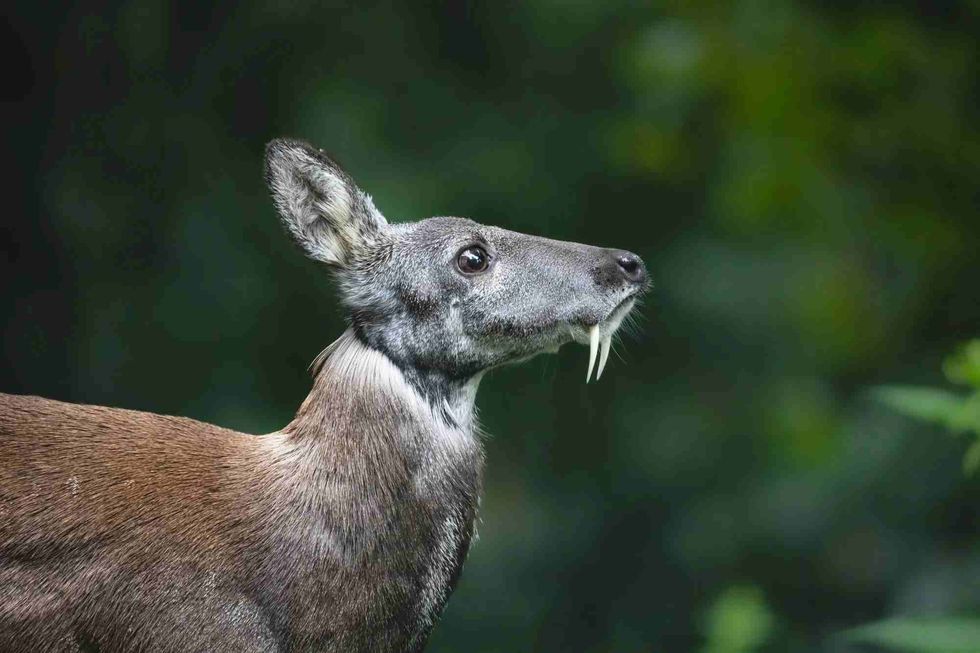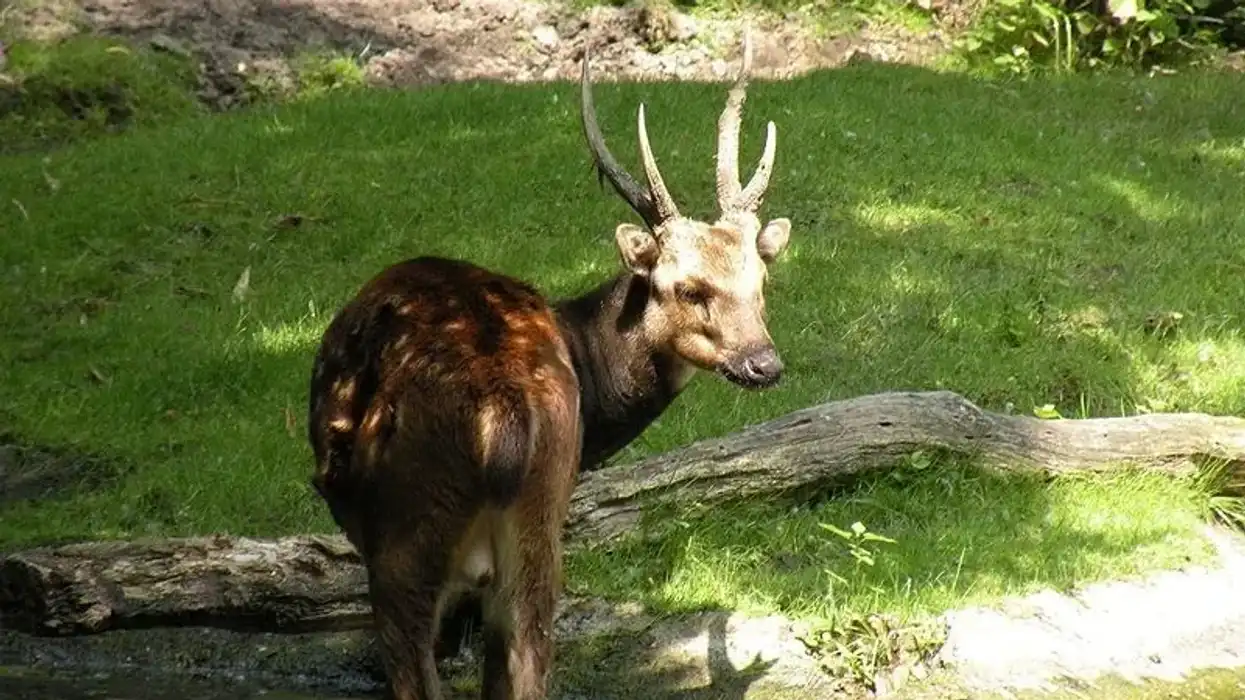The Siberian musk deer is a little, stocky musk deer living in the rugged forest districts of northeast Asia. It is most commonly found in the Taiga forest of Siberia.
With a kangaroo-like face, long, solid hind legs, shorter and more vulnerable forelimbs, a small tail, and an especially angled back, these creatures prefer to live with their family in the jungles of northeast Asia and China. In contrast to other deer species, the male deer don't have prongs yet develop canine teeth during the reproducing season.
Look at these interesting facts; if you like these, do also read our black musk deer facts and mule deer facts too.
Siberian Musk Deer Interesting Facts
What type of animal is a Siberian musk deer?
A Siberian musk deer (Moschus moschiferus) is a species of deer that is found in the grasslands and the forest of Asia. It is a herbivore in nature but has two canine teeth protruding out from the two sides of its mouth.
What class of animal does a Siberian musk deer belong to?
A Siberian musk deer (Moschus moschiferus) belongs to the class Mammalia.
How many Siberian musk deer are there in the world?
There is actually no exact estimate of the total population of the Siberian musk deer in the world, but due to excessive hunting for their musk in Asia and China, their population is continually decreasing, and soon they can become an endangered species.
Where does a Siberian musk deer live?
A Siberian musk deer (Moschus moschiferus) prefers to live in mountainous terrains covered with grasslands and forests, especially in Asia.
What is a Siberian musk deer's habitat?
The Siberian musk deer habitat changes along with time, and according to the season and they migrate as per their need. Throughout the cold winter months, these creatures live on steep slants or slopes. From the beginning of late spring, they change their habitat and move to grasslands or forests alongside river valleys or even rocky mountain regions.
Who do Siberian musk deer live with?
These endangered species of musk deer are shy animals, and they mostly live a solitary life or form groups consisting of two to three individuals, ideally in the Taiga of Siberia.
How long does a Siberian musk deer live?
A Siberian musk deer lives between 10-20 years.
How do they reproduce?
During the season of mating that lasts roughly between the winter months of November to December, young male deers develop tusks rather than antlers. These tusks are used to rival other young males and draw in young females.
When the male and the female deer have copulated, the females get pregnant, and the gestation lasts for about six months. Females give birth to one or two fawns, normally between the long stretches of May to June.
What is their conservation status?
Their conservation status, as of now, is Vulnerable according to the IUCN, but their population is continuously decreasing, and they are soon to become endangered animals because of deforestation and humans hunting for musk.
Siberian Musk Deer Fun Facts
What do Siberian musk deers look like?

These Endangered species of musk deer are brown and black in color, with two fangs coming out of the side of their mouth. It has a short body with thin front legs and stronger hind legs. They have a three musk gland system that secretes musk, which is a vital ingredient used in many household and luxury items.
How cute are they?
Siberian musk deers are not very cute animals as they don't have an appeasing appearance due to their thin front legs and thick hind legs.
How do they communicate?
Siberian musks are not very vocal animals, and they communicate through a soft hissing sound that is also known as Siberian musk deer call. They are very specific about their territories, and they use their feces which has a characteristic odor and serves as a form of communication between the other species.
How big is a Siberian musk deer?
Siberian musk deer's length range from 33.8-39.3 in (86-100 cm) and they are relatively shorter than a normal wild deer which has a height range of about 37-87 in (95-220 cm).
How fast can a Siberian musk deer run?
The exact speed of a Siberian musk deer has not yet been found out, but it is estimated somewhere around 60 mph (96.5 kph), which is the average speed of other species of deer.
How much does a Siberian musk deer weigh?
A Siberian musk deer weighs between 24.2-39.6 lb ( 11-18 kg) which is almost two times less than an average wild deer which weighs somewhere around 90 lb (40 kg).
What are the male and female names of the species?
The males of this species are called bucks or stags, and the females are called does or hinds.
What would you call a baby Siberian musk deer?
A baby Siberian musk deer is called a fawn.
What do they eat?
A Siberian musk deer is a herbivore, and the diet of their entire population range is the leaves and bark of trees, bird cherry, willow, buds, and honeysuckle. Their diet also varies according to the season.
Are they dangerous?
No, they are not very dangerous as they are kind of shy animals and prefer to spend a solitary life.
Would they make a good pet?
They wouldn't make a good pet as they are not domestic in nature and don't fit well with family and children and also, creating a habitat that would suit their needs is very difficult, which further lowers the chance of taming them.
Did you know...
A Siberian musk deer has unique fangs or canine teeth to compete with other male deers and attract female deers.
The Siberian musk deers specialty is that it has four stomachs, but only one of which is used, and all the others are considered as 'false stomachs'.
They are not very aggressive, but they are very specific about their territories. Their population is becoming endangered due to overhunting in regions of north Asia and China for their musk. To save their population from being endangered, the government is trying to create a more habitable environment for them by promoting afforestation and placing them under protective measures.
Some other musk deers include the Himalayan musk deer and black musk deer.
What is the specialty of Siberian musk deer?
Siberian musk deer's specialties include the presence of two sets of canine teeth, which are used by young males to attract females. They also secrete musk from their three musks secreting gland, which is a very important ingredient for the perfume industry.
Apart from that, they have four stomachs, only one of which is used by them, and the remaining are 'false stomachs'.
Why is the Siberian musk deer endangered?
Siberian musk deer is under the Vulnerable category, but their species is soon going to be endangered as their population is decreasing because of overhunting in north Asia and the Northeastern region for their musk. To save them from becoming endangered, the government has protected them under various laws.
Here at Kidadl, we have carefully created lots of interesting family-friendly animal facts for everyone to discover! Learn more about some other mammals from our Annamite striped rabbit facts or Himalayan musk deer facts pages.
You can even occupy yourself at home by coloring in one of our free printable Siberian musk deer coloring pages.









